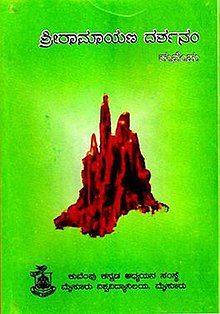
The Ramayana, also known as Valmiki Ramayana, as traditionally attributed to Valmiki, is a smriti text from ancient India, one of the two important epics of Hinduism known as the Itihasas, the other being the Mahabharata. The epic narrates the life of Rama, the seventh avatar of the Hindu deity Vishnu, who is a prince of Ayodhya in the kingdom of Kosala. The epic follows his fourteen-year exile to the forest urged by his father King Dasharatha, on the request of Rama's stepmother Kaikeyi; his travels across forests in the Indian subcontinent with his wife Sita and brother Lakshmana; the kidnapping of Sita by Ravana, the king of Lanka, that resulted in war; and Rama's eventual return to Ayodhya along with Sita to be crowned king amidst jubilation and celebration.
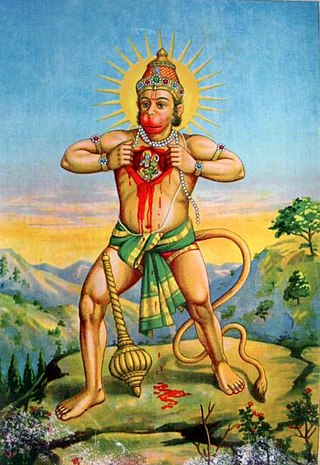
Hanuman, also known as Maruti, Bajrangabali, and Anjaneya, is a deity in Hinduism, revered as a divine vanara, and a devoted companion of the deity Rama. Central to the Ramayana, Hanuman is celebrated for his unwavering devotion to Rama and is considered a chiranjivi. He is traditionally believed to be the spiritual offspring of the wind deity Vayu, who is said to have played a significant role in his birth. In Shaivite tradition, he is regarded to be an incarnation of Shiva, while in most of the Vaishnavite traditions he is the son and incarnation of Vayu. His tales are recounted not only in the Ramayana but also in the Mahabharata and various Puranas.

Lakshmana, also known as Laxmana, Lakhan, Saumitra, and Ramanuja, is the younger brother of Rama in the Hindu epic Ramayana. He is considered as an incarnation of Shesha, the lord of serpents. Lakshmana was married to Urmila, and is known for his loyalty and dedication towards Rama.

In the Hindu epic Ramayana, Maricha, or Mareecha is a rakshasha, who was killed by Rama, the hero of the epic and an avatar of Vishnu. He is mentioned as an ally of Ravana, the antagonist of the epic. His most notable exploit is his role in the kidnapping of Sita, Rama's wife. His son Kalanemi was killed by Hanuman.
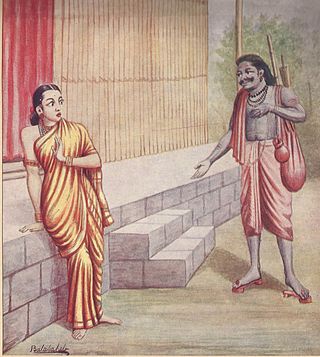
Lakshmana Rekha, in some later versions of the Hindu epic Ramayana, is a line in the soil drawn by Lakshmana. This line is drawn around the dwelling in the forest that he shared with his elder brother, Rama, and Rama's wife, Sita. The line is meant to protect Sita, while he was away searching for Rama. This line is not featured in the original epic by Valmiki.
Raghuvaṃśa is a Sanskrit epic poem (mahakavya) by the celebrated Sanskrit poet Kalidasa. Though an exact date of composition is unknown, the poet is presumed to have flourished in the 5th century CE. It narrates, in 19 sargas (cantos), the stories related to the Raghu dynasty, namely the family of Dilipa and his descendants up to Agnivarna, who include Raghu, Dasharatha and Rama.

Sita, also known as Siya, Janaki and Maithili, is a Hindu goddess and the female protagonist of the Hindu epic Ramayana. Sita is the consort of Rama, the avatar of god Vishnu, and is regarded as an avatar of goddess Lakshmi. She is the chief goddess of the Ramanandi Sampradaya and is the goddess of beauty and devotion. Sita's birthday is celebrated every year on the occasion of Sita Navami.
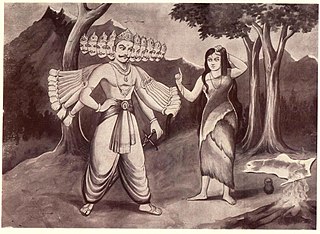
Vedavati is the previous birth of the goddess Sita in Hindu mythology. She is an avatar of the goddess of prosperity, Lakshmi.

Adhyatma Ramayana is a 13th- to 15th-century Sanskrit text that allegorically interprets the story of Hindu epic Ramayana in the Advaita Vedanta framework. It is embedded in the latter portion of Brahmānda Purana, and the author is considered to be Vyasa. The Hindu tradition also attributes the text to the Bhakti movement saint Ramananda.

Shurpanakha, is a rakshasi (demoness) in Hindu epic. Her legends are mainly narrated in the epic Ramayana and its other versions. She was the sister of Lanka's king, Ravana, and the daughter of the sage Vishrava and the rakshasi Kaikeshi. Shurpanakha's role in the original epic is small, yet significant.
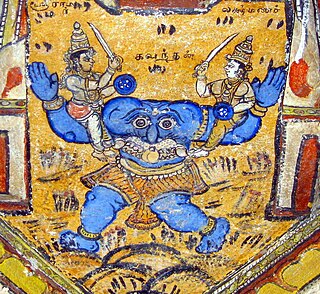
In Hinduism, Kabandha is a Rakshasa (demon) who is killed and freed from a curse by the god Rama – an Avatar of Vishnu – and his brother Lakshmana. Kabandha's legend appears in the Hindu epics Ramayana and Mahabharata, as well as in later Ramayana adaptations.
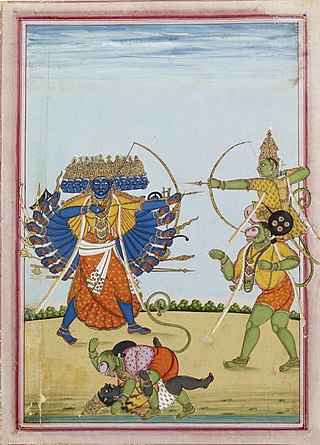
Depending on the methods of counting, as many as three hundred versions of the Indian Hindu epic poem, the Ramayana, are known to exist. The oldest version is generally recognized to be the Sanskrit version attributed to the sage Narada, the Mula Ramayana. Narada passed on the knowledge to Valmiki, who authored Valmiki Ramayana, the present oldest available version of Ramayana.
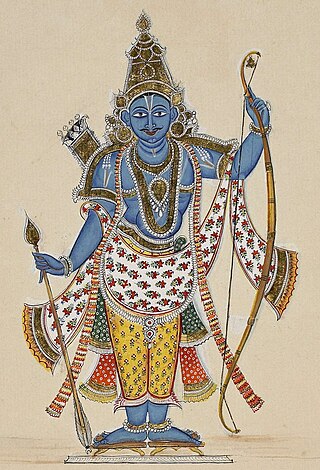
Rama is a major deity in Hinduism. He is worshipped as the seventh and one of the most popular avatars of Vishnu. In Rama-centric Hindu traditions, he is considered the Supreme Being. Also considered as the ideal man, Rama is the male protagonist of the Hindu epic Ramayana. His birth is celebrated every year on Rama Navami, which falls on the ninth day of the bright half of the lunar cycle of Chaitra (March–April), the first month in the Hindu calendar.

Sampoorna Ramayanam is a 1958 Indian Tamil-language Hindu mythological film directed by K. Somu. It is based on Valmiki's Ramayana. The film stars N. T. Rama Rao in the lead role of Rama and Sivaji Ganesan as Bharatha. It was released on 14 April 1958 and ran for over 264 days in theatres, thereby becoming a silver jubilee hit. The film was dubbed into Hindi as Ramayan in 1960.

In some adaptations of the Hindu epic Ramayana, Maya Sita or Chaya Sita is the illusionary duplicate of the goddess Sita, who is abducted by the demon-king Ravana of Lanka instead of the real Sita.

Rama (Rāma), the hero of Ramayana, is described in the Jain scriptures as one of sixty-three illustrious persons, known as Salakapurusa. Among these, there are nine sets of Balabhadra, Vasudeva and Prati-Vasudeva. Rama was the 8th Balabhadra with Lakshmana and Ravana being his Vasudeva and Prati-Vasudeva counterparts. He is described as a young prince who is deprived of his throne and turned into a pauper. While living in exile his wife Sita is kidnapped by Ravana, King of Lanka. Rama then rescues Sita with the help of his brother Lakshmana and King Sugriva. Ravana is killed by Lakshmana and they both go into hell. Rama becomes a Jain muni and his soul attains moksha. Sita becomes a Jain sadhvi and is born into heaven as Indra.

Trijata is a rakshasi (demoness) in the Hindu epic Ramayana who is assigned the duty of guarding Sita who was kidnapped by the demon-king of Lanka Ravana. In later adaptions of Ramayana, Trijata is described as a daughter of Vibhishana, the brother of Ravana.
Nagachandra or Abhinava Pampa was a 12th-century poet in the Kannada language.
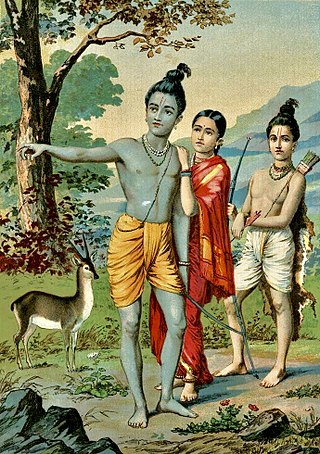
The exile of Rama is an event featured in the Ramayana, and is an important period in the life of Rama. In the epic, Rama is exiled by his father, Dasharatha, under the urging of his step-mother Kaikeyi, accompanied by his wife Sita and half-brother Lakshmana for 14 years. Rama's exile is a prelude to subsequent events of the epic, such as abduction of his wife Sita, his meeting with Hanuman and Sugriva, his battle with Ravana, and ultimately, the killing of Ravana, the purpose for which Vishnu had incarnated himself as Rama.
